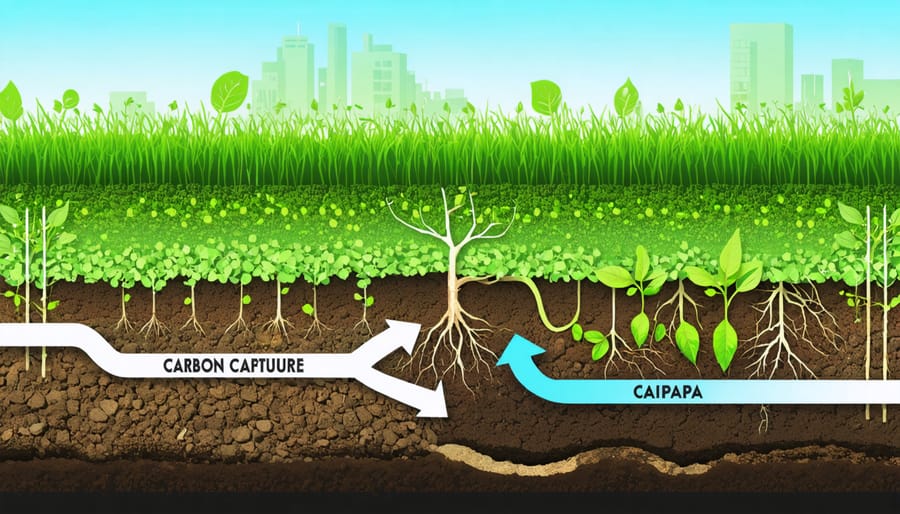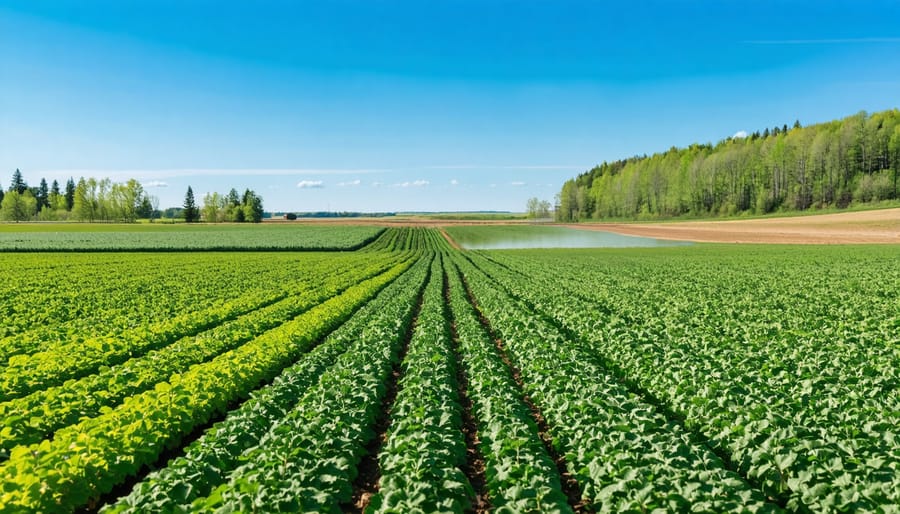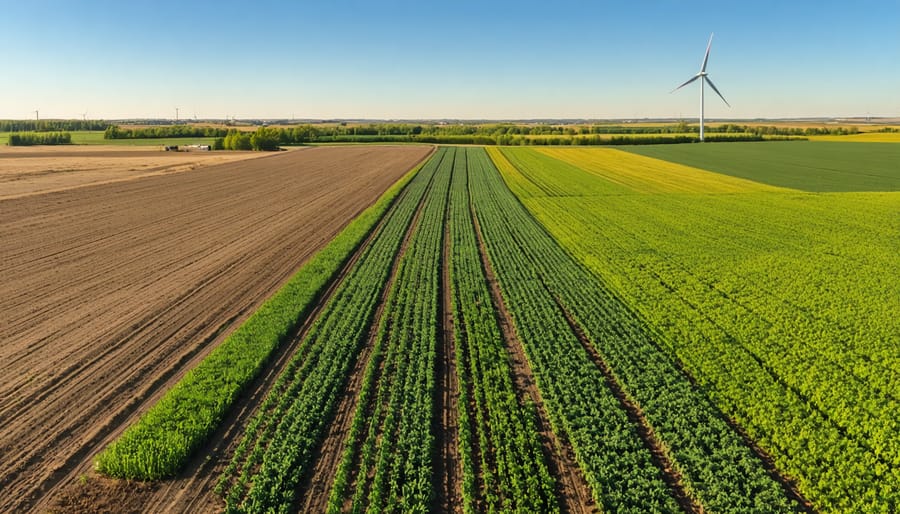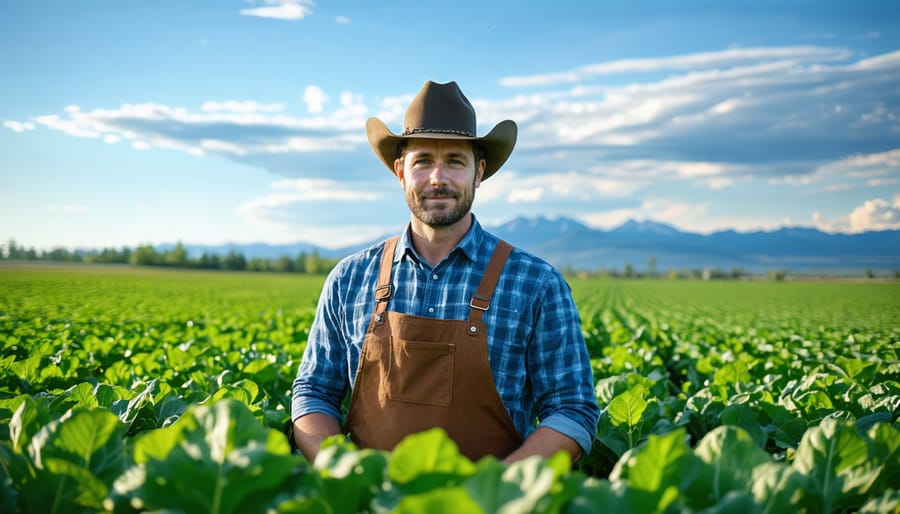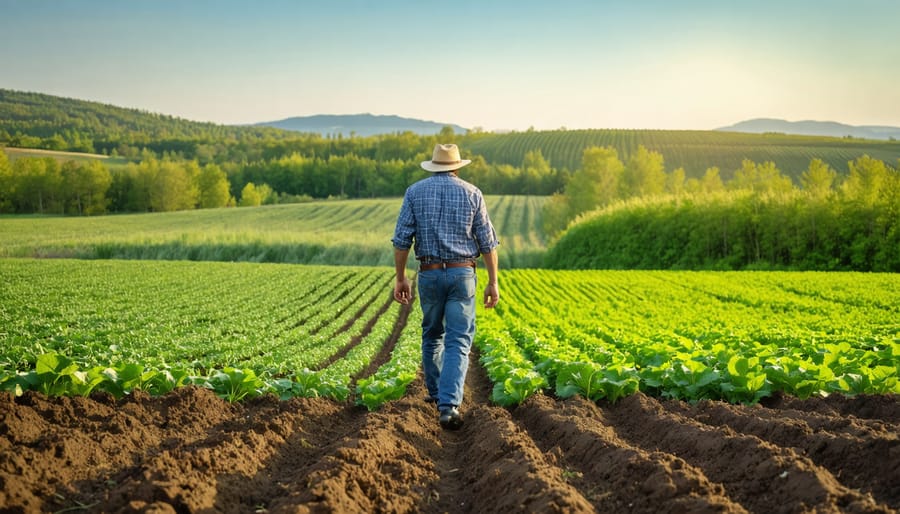Deep beneath our feet lies a complex carbon exchange system that’s revolutionizing how Alberta farmers approach soil management. The soil carbon cycle – a dynamic interplay between plants, microorganisms, and soil particles – holds the key to both agricultural productivity and climate change mitigation. Through innovative carbon farming practices, Canadian producers are transforming their fields into powerful carbon sinks while enhancing soil fertility and crop yields.
As regulations evolve and carbon markets emerge, understanding this vital process has become more than an environmental concern – it’s a strategic business opportunity. Alberta’s agricultural sector stands at the forefront of soil carbon management, with farmers pioneering techniques that balance regulatory compliance with practical field operations. From precision agriculture to regenerative practices, these methods are reshaping our understanding of soil’s role in sustainable farming.
This living system beneath our crops doesn’t just store carbon – it builds resilience into our agricultural operations, creates new revenue streams through carbon credits, and positions Canadian agriculture as a leader in climate-smart farming solutions.
The Soil Carbon Economy: Your Farm’s Hidden Bank Account

Understanding Your Soil’s Carbon Balance Sheet
Think of your soil’s carbon balance like a farm bank account – you’ve got deposits coming in and withdrawals going out. The main carbon deposits come from crop residues, root systems, and organic amendments like manure or compost. These materials break down over time, adding valuable organic carbon to your soil.
On the withdrawal side, farming practices like tillage, bare fallowing, and intensive cropping can release carbon back into the atmosphere. When soil is disturbed, microorganisms break down organic matter more quickly, leading to carbon loss through CO2 emissions.
Here in Alberta, we typically see carbon inputs peak during our growing season, especially with practices like cover cropping and crop rotation. Carbon losses tend to be highest during spring tillage and summer fallow periods. Understanding this balance helps you make informed decisions about your soil management practices.
The goal is to maintain more carbon deposits than withdrawals, building what we call a positive carbon balance. This not only helps with soil health but also positions your farm well for potential carbon credit opportunities in our province.
Measuring Your Soil’s Carbon Value
Modern soil testing methods make it easier than ever to measure your soil’s carbon content accurately. Here in Alberta, farmers can access several testing options through certified soil laboratories that provide detailed carbon analysis. The most common method involves collecting soil samples from different depths and locations across your field, typically at 0-15 cm and 15-30 cm depths.
For reliable results, take samples from at least 10 different spots per field, focusing on areas that represent your typical soil conditions. Many Alberta farmers find it helpful to mark these sampling locations using GPS coordinates for consistent long-term monitoring.
Local agricultural extension offices offer sampling equipment rentals and guidance on proper collection techniques. Basic carbon testing kits are available, but for carbon credit programs, you’ll need analysis from accredited labs that use methods like dry combustion or loss-on-ignition testing.
When interpreting results, consider that healthy Alberta soils typically contain 2-5% organic carbon in the top layer. Regular testing, ideally every 2-3 years, helps track changes in your soil’s carbon levels and guides management decisions for optimal soil health.
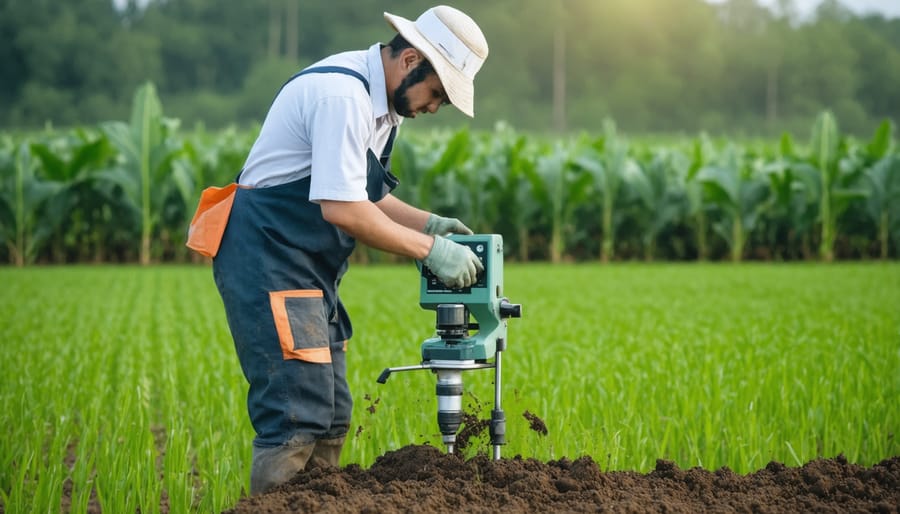
Current Carbon Regulations Affecting Alberta Farms
Provincial Carbon Credit Programs
Alberta leads Canada in agricultural carbon offset programs, offering farmers opportunities to earn soil carbon credits through sustainable farming practices. The program recognizes various activities that enhance soil carbon sequestration, including conservation tillage, continuous cropping, and precision farming techniques.
Farmers can earn approximately $15 to $30 per hectare annually by implementing approved carbon sequestration practices. The verification process involves detailed record-keeping of farming activities, soil testing, and third-party validation. Participating farmers must maintain these practices for a minimum of three years to qualify for credits.
The success of Alberta’s system has inspired other provinces to develop similar programs. Local farmer Mike Anderson from Camrose shares, “Since joining the program five years ago, we’ve not only improved our soil health but also created an additional revenue stream that helps offset the costs of implementing sustainable practices.”
To participate, farmers must first register with approved aggregators who help bundle credits from multiple farms. These aggregators handle the documentation and trading processes, making it easier for individual farmers to access the carbon market. The program continues to evolve, with new protocols being developed to recognize additional farming practices that contribute to carbon sequestration.
Federal Clean Fuel Standards
Canada’s Federal Clean Fuel Standards (CFS) are reshaping how farmers approach soil management, offering new opportunities for those who adopt carbon-conscious practices. These regulations, which came into effect in 2023, create a framework that recognizes and rewards agricultural practices that enhance soil carbon sequestration.
For Alberta farmers, the standards present promising pathways to generate additional revenue through carbon credits while improving soil health. Practices like reduced tillage, cover cropping, and precision nutrient management not only comply with CFS requirements but also build more resilient farming operations.
The regulations specifically acknowledge soil carbon enhancement as a valid pathway for credit generation. Farmers who document their carbon-building practices and demonstrate measurable improvements in soil organic matter can participate in the credit market. Many Alberta producers are already seeing success with this approach, combining traditional farming wisdom with modern carbon management strategies.
To support farmers in this transition, Agriculture and Agri-Food Canada provides technical assistance and resources for implementing CFS-compliant practices. Local agricultural extension offices offer guidance on soil testing, record-keeping, and verification procedures necessary for credit generation.
The standards also align with provincial initiatives, creating a harmonized approach to soil carbon management that benefits both the environment and farm economics. This integration helps farmers streamline their compliance efforts while maximizing the potential benefits of their soil improvement practices.
Practical Strategies for Carbon-Smart Farming
No-Till Practices and Carbon Credits
Alberta’s agricultural landscape is witnessing a significant shift as more farmers embrace no-till farming benefits while participating in carbon credit programs. These practices not only enhance soil health but also align with provincial carbon offset protocols, creating new revenue streams for farm operations.
Under current Alberta regulations, farmers can earn carbon credits by implementing verified no-till practices that demonstrably increase soil carbon sequestration. The program requires maintaining detailed records of field operations, including seeding methods and residue management practices, for a minimum of five years.
Local success stories, like the Smith family farm near Red Deer, showcase how integrating no-till practices with carbon credit programs can work effectively. Their operation has earned additional income through carbon credits while improving soil structure and reducing operational costs.
To qualify for carbon credits, farmers must:
– Maintain continuous no-till practices
– Document baseline soil carbon levels
– Track and report annual farming activities
– Work with approved verification bodies
– Meet minimum practice change requirements
Many Alberta farmers are finding that the administrative requirements of carbon credit programs are manageable when integrated into existing farm management systems. Support networks, including local agricultural extension services and farmer-led groups, are available to help navigate the verification process and maximize both environmental and financial benefits.

Cover Cropping for Carbon Benefits
Cover cropping has emerged as a powerful tool for Alberta farmers looking to enhance their soil’s carbon storage capacity while meeting provincial carbon regulations. By maintaining living roots in the soil throughout the year, cover crops actively pull carbon dioxide from the atmosphere and convert it into stable soil organic matter.
In the Prairie region, successful cover crop strategies often include cold-hardy species like fall rye, winter wheat, and hairy vetch. These crops can be seeded after harvest and continue growing into late fall, maximizing the carbon capture window. Many Alberta farmers report significant success with cocktail mixes that combine cereals, legumes, and brassicas, which not only increase carbon sequestration but also improve soil structure and nutrient cycling.
Local farmer Dave Thompson from Red Deer County shares, “Since implementing cover crops five years ago, we’ve noticed improved soil tilth and reduced erosion. The carbon credits are an added bonus to the overall soil health benefits.” The Alberta Carbon Offset System recognizes cover cropping as an eligible practice for carbon credits, providing an additional revenue stream for farmers who adopt this management strategy.
To maximize carbon benefits, consider:
– Selecting species that establish quickly in your local climate
– Maintaining living cover for as long as possible
– Minimizing soil disturbance during termination
– Including diverse species in your cover crop mix
– Documenting your practices for carbon credit verification
Crop Rotation Strategies
Effective crop rotation is a cornerstone of successful carbon sequestration strategies in Alberta’s agricultural landscape. By thoughtfully planning rotation cycles, farmers can maximize soil carbon storage while maintaining productive yields.
A well-designed three to four-year rotation typically includes a deep-rooted perennial crop, followed by nitrogen-fixing legumes, and then traditional grain crops. For example, many Alberta farmers start with alfalfa, followed by field peas, then wheat, and finally canola. This sequence allows for optimal carbon accumulation while providing diverse income streams.
Including cover crops during shoulder seasons further enhances carbon storage. Quick-growing species like fall rye or winter wheat protect soil through harsh prairie winters while contributing valuable organic matter. Local success stories show that farms implementing these rotation patterns have increased soil organic carbon by 0.2 to 0.5% over five years.
Key considerations for rotation planning include:
– Alternating between shallow and deep-rooted crops
– Including at least 30% legumes in the rotation
– Maintaining living roots in the soil as long as possible
– Considering market opportunities for chosen crops
Remember that rotation benefits compound over time. While initial changes may seem subtle, consistent implementation leads to significant improvements in soil structure, water retention, and carbon storage capacity.
Real Success Stories from Alberta Farms
Meet James Anderson, a third-generation farmer from Lethbridge County, who transformed his 2,000-hectare grain operation into a carbon management success story. “When carbon regulations first came in, I was worried,” James admits. “But implementing no-till practices and cover cropping has actually increased our soil health and profit margins by 15% over three years.”
In the Peace River region, Sarah Martinez runs a mixed farming operation where she’s pioneered innovative crop rotation strategies. By incorporating pulse crops and implementing precision agriculture techniques, she’s documented a significant increase in soil organic carbon while meeting regulatory requirements. “We’ve reduced our fertilizer costs by 20% while maintaining yields,” Sarah reports. “The soil tests show we’re sequestering about 2 tonnes of carbon per hectare annually.”
The Wilson family farm near Red Deer represents another success story in carbon management. After adopting regenerative grazing practices and implementing a comprehensive soil monitoring program, they’ve seen remarkable improvements. “Our soil organic matter increased from 2% to 4.5% in five years,” explains Tom Wilson. “We’re not just complying with regulations; we’re building a more resilient operation.”
In Southern Alberta, the Chang family’s market garden operation demonstrates how smaller farms can excel in carbon management. By implementing composting systems and minimal tillage practices, they’ve created a model of sustainability while meeting regulatory requirements. “We’ve reduced our greenhouse gas emissions by 30% while improving our soil structure,” notes Lisa Chang.
These success stories share common elements: careful planning, systematic implementation, and consistent monitoring. Each farmer emphasizes the importance of starting small and scaling up successful practices. They’ve all utilized Alberta’s agricultural extension services and participated in soil health workshops to build their knowledge base.
The results speak for themselves: improved soil structure, better water retention, reduced input costs, and increased crop resilience to weather extremes. These farmers aren’t just managing carbon – they’re building better businesses while contributing to environmental sustainability.
Remember: success in carbon management looks different for every farm, but these examples show it’s achievable with the right approach and support.
As Alberta’s farming community continues to embrace soil carbon management, we’re seeing promising results in both environmental stewardship and farm productivity. The soil carbon cycle is fundamental to sustainable agriculture, offering solutions for climate challenges while improving crop yields and soil health. Looking ahead, emerging technologies and improved monitoring methods will make it easier for farmers to track and enhance their soil carbon levels. Through collaborative efforts and knowledge sharing within our agricultural community, we’re building a more resilient farming future. Remember, every management decision you make today affects tomorrow’s soil health and farm productivity. By understanding and working with the soil carbon cycle, you’re not just improving your land – you’re contributing to Canada’s sustainable agricultural legacy.

